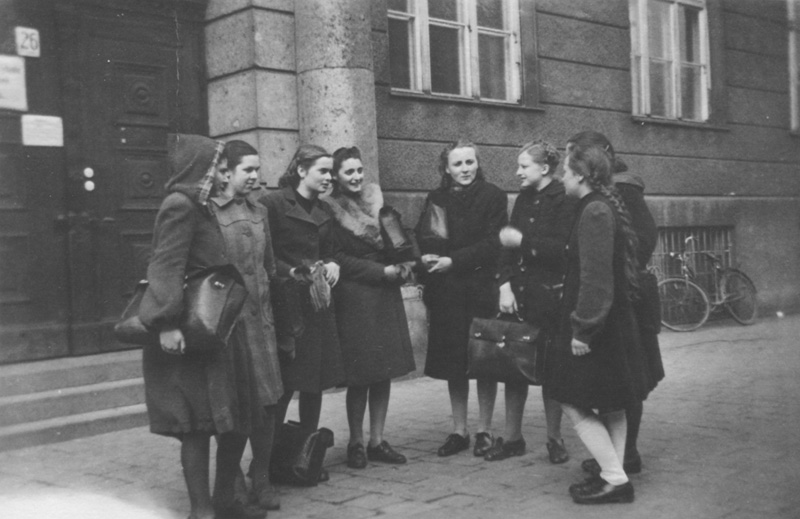Christine Roths Vater Bruno (1896-1984) entstammte einer jüdischen Münchner Mehlhändlerfamilie. Er war für verschiedene Firmen als Provisionsvertreter für Textil- und Kurzwaren tätig. 1924 trat er aus der jüdischen Kultusgemeinde aus und heiratete im Jahr darauf die Katholikin Else Walter. Christine Roth und ihre jüngeren Schwestern Gertrude und Elfriede wurden katholisch getauft und erzogen. Die Familie lebte in Bogenhausen, zunächst in der Cuvilliésstraße 1, ab 1934 in der Schneckenburgerstraße 42. Christine Roth besuchte einen privaten Kindergarten, anschließend die Volksschule am Versailler Platz (heute Ernst-Reuter-Straße 4) und das katholische Mädchengymnasium im Angerkloster.
Nach der Machtübernahme der Nationalsozialisten wuchsen sie und ihre Geschwister zunächst noch recht behütet im katholischen Milieu auf. Mit dem Erlass der ‚Nürnberger Gesetze‘ 1935 beeinträchtigten jedoch die sich verschärfenden antijüdischen Maßnahmen zunehmend das Leben der Familie. Für Bruno Roth wurde es immer schwieriger, Aufträge zu bekommen. Im Juli 1938 schließlich wurde Menschen jüdischer Herkunft die Ausübung einer Vertretertätigkeit grundsätzlich untersagt. Bruno Roth versuchte nun als Fotograf, einem seiner Hobbys, den Lebensunterhalt der Familie zu sichern; zu seinen wichtigsten Kund*innen zählte dabei die Münchner Katholische Kirchenzeitung.
Nach dem Novemberpogrom 1938 bemühte er sich, in die USA auszuwandern, was ihm im Sommer 1939 gelang. Der Plan, die Familie nachzuholen, scheiterte aufgrund des Beginns des Zweiten Weltkriegs. Die finanzielle Situation der Zurückgebliebenen wurde zunehmend prekär. Ende 1940 zogen sie in eine kleinere Wohnung in der Richard-Strauß-Straße 1 um. Ersparnisse und Unterstützung seitens der Verwandtschaft sicherten das Überleben, ehe die Mutter eine Anstellung als Näherin fand.
Während ihrer Schulzeit im Angerkloster gehörte Christine Roth einer Mädchengruppe des aus der katholischen Jugendbewegung hervorgegangenen Heliand-Bundes an. Auch nach dem Verbot aller katholischen Jugendgruppen 1939 trafen sich die Mädchen heimlich fast wöchentlich zu Diskussionen und Singstunden, manchmal auch zu Ausflügen. Betreut wurde die Gruppe von Pater Alfred Delp, der wegen seiner Zugehörigkeit zum Kreisauer Kreis nach dem Attentat vom 20.7.1944 verhaftet, zum Tod verurteilt und hingerichtet wurde. Nachdem eine Verordnung vom Juli 1942 auch vom NS-Regime als ‚Halbjuden‘ eingestuften Personen den Besuch höherer Schulen verboten hatte, musste Christine Roth das Gymnasium verlassen. Ein Bruder ihrer Mutter vermittelte ihr eine Anstellung als Jungarbeiterin (Praktikantin) in einem Chemielabor der Klinik an der Nußbaumstraße.
1946 emigrierte Christine Roth mit ihrer Mutter und ihren Schwestern in die USA zum Vater. Sie studierte dort Pädagogik, arbeitete als Grundschullehrerin und Privatsekretärin. 1959 heiratete sie Max Schurtman, einen aus Wien stammenden jüdischen Rechtsanwalt, der der Shoah durch Emigration nach Shanghai entkommen war. Das Paar hatte zwei Töchter und lebte in New York, wo Christine Roth 2015 verstarb.


